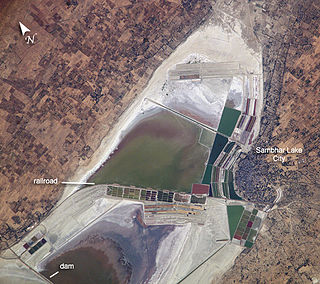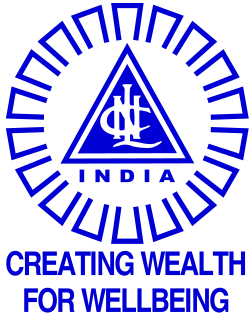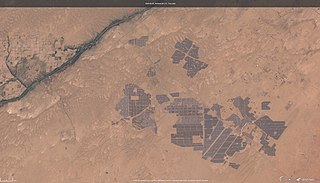Related Research Articles

Praful Manoharbhai Patel is an Indian politician. His father, Manoharbhai Patel, an Indian National Congress leader who was elected to represent Gondia Bhandara districts in Maharashtra. His political career began in 1991 and he was appointed as the Union Minister of Civil Aviation in 2004. His family runs the CEEJAY group, a large tobacco conglomerate in India.

The Sambhar Salt Lake, India's largest inland salt lake, is located in Sambhar Lake Town, Jaipur district of Rajasthan, India, 80 km (50 mi) southwest of the city of Jaipur and 64 km (40 mi) northeast of Ajmer, Rajasthan. It surrounds the historical Sambhar Lake Town.

NLC India Limited (NLC) is a government-owned-fossil fuel miner and thermal power generator under the ownership of Ministry of Coal, Government of India. It annually produces about 30 million tonnes of Lignite from opencast mines at Neyveli in the state of Tamil Nadu in southern India and at Barsingsar in Bikaner district of Rajasthan state. The lignite is used at pithead thermal power stations of 3640 MW installed capacity to produce electricity. Its joint venture has a 1000 MW thermal power station using coal. Lately, it has diversified into renewable energy production and installed 1404 MW solar power plant to produce electricity from photovoltaic (PV) cells and 51 MW electricity from windmills.

Tata Power Company Limited is an Indian electric utility company based in Mumbai, Maharashtra, India and is part of the Tata Group. The core business of the company is to generate, transmit and distribute electricity. With an installed electricity generation capacity of 10,577 MW, it is India's largest integrated power company. Tata Power has been ranked 3rd in 2017 Responsible Business Rankings developed by IIM Udaipur. In February 2017, Tata Power became the first Indian company to ship over 1 GW solar modules.
Sambhar is a town and a municipality in Jaipur district in the Indian state of Rajasthan. It is surrounded by the Sambhar Salt Lake. Sambhar is approximately 70 km from Jaipur and 99 km from Ajmer.
Ultra Mega Power Projects (UMPP) are a series of ambitious power stations planned by the Government of India. This would entail the creation of an additional capacity of at least 100,000 MW by 2022. Ultra Mega Power projects, each with a capacity of 4000 MW or above, are being developed with the aim of bridging this gap.

Wind power generation capacity in India has significantly increased in recent years. As of 30 November 2021, the total installed wind power capacity was 40 GW, the fourth largest installed wind power capacity in the world. Wind power capacity is mainly spread across the Southern, Western and Northern regions.

Solar power in India is a fast developing industry as part of the renewable energy in India. The country's solar installed capacity was 53.997 GW as of 31 March 2022.
Reliance Power Limited (R-Power), formerly Reliance Energy Generation Limited (REGL) is a part of the Reliance Anil Dhirubhai Ambani Group. It was established to develop, construct, operate and maintain power projects in the Indian and international markets. Reliance Infrastructure, an Indian private sector power utility company and the Reliance ADA Group promote Reliance Power. The present CEO of Reliance Power is K. Raja Gopal since 2 May 2018.
The National Solar Mission is an initiative of the Government of India and State Governments to promote solar power. The mission is one of the several policies of the National Action Plan on Climate Change. The program was inaugurated as the Jawaharlal Nehru National Solar Mission by former Prime Minister Manmohan Singh on 11 January 2010 with a target of 20 GW by 2022. This was later increased to 100 GW by Prime Minister Narendra Modi in the 2015 Union budget of India. India increased its utility solar power generation capacity by nearly 5 times from 2,650 MW on 26 May 2014 to 12,288.83 MW on 31 March 2017. The country added 9,362.65 MW in 2017–18, the highest of any year. The original target of 20 GW was surpassed in 2018, four years ahead of the 2022 deadline.

Adani Power Ltd, is an Indian power and energy company, subsidiary of Indian conglomerate Adani Group with head office at Khodiyar in Ahmedabad, Gujarat. It is a private thermal power producer, with capacity of 12,450 MW.It also operates a mega solar plant of 40 MW at Naliya, Bitta, Kutch, Gujarat. It is India's first company that synchronises the supercritical technology.

GVK Industries Limited d/b/a or GVK Group is an Indian conglomerate stretching across assorted sectors comprising energy, resources, airports and transportation. Having already invested over ₹240 billion (US$3.1 billion), GVK Group has projects in pipeline worth over another ₹360 billion (US$4.7 billion) in India. After acquiring Australian coal mines in Queensland for US$1.26 billion, GVK forecasts an investment of US$10 billion in mine, rail and port project. Its flagship company GVK Power & Infrastructure Limited is listed on both Bombay Stock Exchange (BSE) and National Stock Exchange (NSE) as NSE: GVKPIL.

Power sector of Andhra Pradesh is divided into 4 categories namely Regulation, Generation, Transmission and Distribution. Andhra Pradesh Electricity Regulatory Commission (APERC) is the regulatory body. APGENCO deals with the electricity production and also maintenance, proposes new projects and upgrades existing ones as well. The APGENCO also set up a Special Purpose Vehicle (SPV), named as Andhra Pradesh Power Development Company Limited (APPDCL), a joint venture company of APGENCO and IL&FS to set up Krishnapatanam thermal power project.

Azure Power Global Limited is an independent power producer, a developer and an operator of utility and commercial scale solar PV power plants headquartered in New Delhi, India. The company was founded in 2008 by entrepreneur Inderpreet Wadhwa. The company sells energy to government utilities, and independent industrial and commercial customers in India. Azure Power developed India's first utility scale solar project in 2009 in Awan, Punjab. Azure Power has a total capacity of over 7 GW.

Vikram Solar Limited is an Indian company based in Kolkata, the largest solar module manufacturer in India with 2.5 GW module manufacturing capacity annually and the second-largest solar energy company in India by revenue. The company's primary business focus is manufacturing solar PV modules and also carries out engineering, procurement and construction services and operations & maintenance of solar power plants.
Ultra Mega Solar Power Projects, also known as Ultra Mega Solar Parks, are a series of solar power projects planned by the Ministry of New and Renewable Energy of the Union Government of India. Each power project has a minimum capacity of 500 MW.

Bhadla Solar Park is the largest solar park in the world as of 2021, and is spread over a total area of 5,700 hectares in Bhadla, Phalodi tehsil, Jodhpur district, Rajasthan, India.

Pavagada Solar Park is a solar park covering an area of 53 square kilometres in Pavagada taluk, Tumkur district, Karnataka. Completed in 2019, the park has a capacity of 2,050 MW. As of April 2021, it is the World's third largest photovoltaic solar park after the 2,245 MW Bhadla Solar Park in Rajasthan and 2,200 MW Huanghe Hydropower Hainan Solar Park in China. The total project cost was ₹14,800 crore.

Kurnool Ultra Mega Solar Park in Andhra Pradesh is a solar park spread over a total area of 24 square kilometres (9.3 sq mi) in Panyam mandal of Kurnool district, Andhra Pradesh, with a capacity of 1000 MW. It was inaugurated by then chief minister of Andhra Pradesh Nara Chandrababu Naidu on 8 Jan 2019 The park was built at an investment of around ₹70 billion (US$920 million) by solar power developers and the Central and State governments. Solar power developers invested ₹10 billion (US$130 million), while the remaining ₹60 billion (US$790 million) was funded by APSPCL supported by a ₹2 billion (US$26 million) grant from the Union Government.
References
- ↑ "BHEL signs MoU for setting up an Ultra Mega Solar Power Project at Sambhar in Rajasthan". Pib.nic.in. Retrieved 24 July 2016.
- ↑ "BHEL, 5 PSUs to set up 4,000 MW solar plant in Rajasthan". The Hindu. 29 January 2014. Retrieved 24 July 2016.
- ↑ "Bharat Heavy Electricals Ltd". Bhel.com. 1 February 2014. Retrieved 24 July 2016.
- ↑ elets (22 July 2014). "BHEL signs MoU for mega solar power project in Rajasthan | Smart City". Smartcity.eletsonline.com. Retrieved 24 July 2016.
- ↑ Sinha, Shishir (12 December 2014). "Rajasthan mega solar project likely to be shifted to Gujarat". The Hindu Business Line. Retrieved 10 March 2017.
